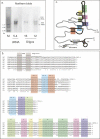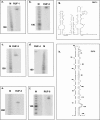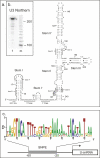Structural RNAs of known and unknown function identified in malaria parasites by comparative genomics and RNA analysis
- PMID: 17901154
- PMCID: PMC2040097
- DOI: 10.1261/rna.751807
Structural RNAs of known and unknown function identified in malaria parasites by comparative genomics and RNA analysis
Abstract
As the genomes of more eukaryotic pathogens are sequenced, understanding how molecular differences between parasite and host might be exploited to provide new therapies has become a major focus. Central to cell function are RNA-containing complexes involved in gene expression, such as the ribosome, the spliceosome, snoRNAs, RNase P, and telomerase, among others. In this article we identify by comparative genomics and validate by RNA analysis numerous previously unknown structural RNAs encoded by the Plasmodium falciparum genome, including the telomerase RNA, U3, 31 snoRNAs, as well as previously predicted spliceosomal snRNAs, SRP RNA, MRP RNA, and RNAse P RNA. Furthermore, we identify six new RNA coding genes of unknown function. To investigate the relationships of the RNA coding genes to other genomic features in related parasites, we developed a genome browser for P. falciparum (http://areslab.ucsc.edu/cgi-bin/hgGateway). Additional experiments provide evidence supporting the prediction that snoRNAs guide methylation of a specific position on U4 snRNA, as well as predicting an snRNA promoter element particular to Plasmodium sp. These findings should allow detailed structural comparisons between the RNA components of the gene expression machinery of the parasite and its vertebrate hosts.
Figures






References
-
- Aldous, W.K., Martin, R.K., Kyle, D.E. Stage specific detection and inhibition studies of Plasmodium falciparum telomerase. Mol. Biochem. Parasitol. 1998;95:281–285. - PubMed
-
- Altschul, S.F., Gish, W., Miller, W., Myers, E.W., Lipman, D.J. Basic local alignment search tool. J. Mol. Biol. 1990;215:403–410. - PubMed
-
- Ares M., Jr, Igel, A.H. Lethal and temperature-sensitive mutations and their suppressors identify an essential structural element in U2 small nuclear RNA. Genes & Dev. 1990;4:2132–2145. - PubMed
-
- Ares M., Jr, Weiser, B. Rearrangement of snRNA structure during assembly and function of the spliceosome. Prog. Nucleic Acid Res. Mol. Biol. 1995;50:131–159. - PubMed
-
- Autexier, C., Greider, C.W. Boundary elements of the Tetrahymena telomerase RNA template and alignment domains. Genes & Dev. 1995;9:2227–2239. - PubMed
Publication types
MeSH terms
Substances
Grants and funding
LinkOut - more resources
Full Text Sources
Research Materials
